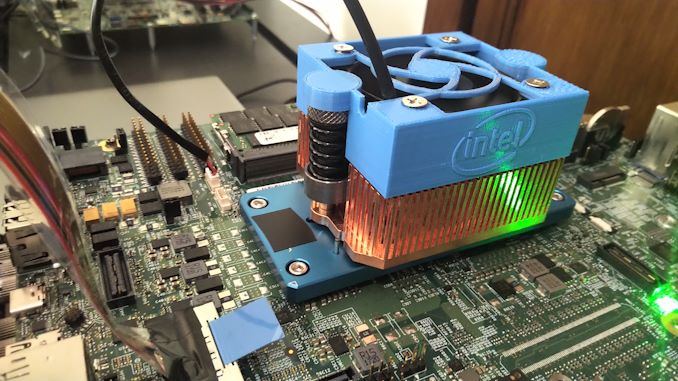Intel's Architecture Day 2018: The Future of Core, Intel GPUs, 10nm, and Hybrid x86
by Dr. Ian Cutress on December 12, 2018 9:00 AM EST- Posted in
- CPUs
- Memory
- Intel
- GPUs
- DRAM
- Architecture
- Microarchitecture
- Xe
Demonstrating Sunny Cove and Gen11 Graphics
As part of the Architecture Event, Intel ran a number of demos on a chip that was supposedly based on the new Sunny Cove cores and Gen11 graphics.
These were development systems with these funky looking heatsinks and loud fans to ensure there was no thermal throttling. One thing worth noticing is that black bit of tape on the heatsink here, which wasn’t present on one of the other demo units.
Hello Ice Lake-U. Being a U-series heatsink, this means that the Core is likely designed for a 15W scenario.
Perhaps it’s no surprise that Intel wasn’t giving anything away in terms of the exact core count on display, speeds, feeds, and power. The demos that were present involved 7-Zip and gaming.
The 7-Zip demo was relatively straight forward, showing how the new instructions such as Vector-AES and SHA-NI in Sunny Cove can give the processor a 75% boost in performance over an equivalent Skylake based platform at iso-frequency. This falls under the ‘specialist’ improvements to the core rather than the general purpose improvements.
The other demo was Tekken 7, being run on a Sunny Cove + Gen11 machine and compared to a Skylake + Gen9 implementation. It looked a good deal smoother that’s for sure, however it was clear that it had some way to go to be fully out of the 30 FPS minimums.














148 Comments
View All Comments
zodiacfml - Thursday, December 13, 2018 - link
YESRaqia - Thursday, December 13, 2018 - link
For ultra-mobile, not only are battery/power/heat issues but supply is one as well due to Intel being locked down to their own manufacturing division. On top of that, they have a lock on x86 by not licensing to any competitors but AMD, who despite competitive stretches inevitably stumbles (either due to themselves or Intel's non-engineering financial efforts) and leaves the industry with dry spells of performance improvements. Intel's gross margins on their chips remain >60% as a result whereas ARM SoCs even after licensing is closer to 20-30%.Raqia - Thursday, December 13, 2018 - link
Keller declared that the technology is in its infancy, and feature wise the 2019 version of the Atom simply won't be competitive with leading ARM SoCs like the 8cx. The slowness you refer to only occurs when running native 32 bit x86 code on the WOW emulation layer, but the value of this feature is mostly in the compatibility being there at all. If performance and compatibility of legacy code matters to you then certainly Windows on Arm isn't suitable. However, it will matter even less now with the new native compilation tools and ports of important sub platforms like Chromium.29a - Thursday, December 13, 2018 - link
"Windows on ARM is horribly slow and therefore shitty."Sounds a lot like Windows on Atom.
MonkeyPaw - Saturday, December 15, 2018 - link
I’m betting Apple wanted one for MacBook Air, or maybe MS for Surface Go. It would be the right amount of performance for both devices, an both companies would have the clout to get it done. I’d lean toward Apple because the GPU is pretty big.Kevin G - Wednesday, December 12, 2018 - link
Typo:"a physical address space up to 52 bits. This means, according to Intel, that the server processors could theoretically support 4 TB of memory per socket."
That should be petabytes instead of terabytes. The limit is for an entire system, not per socket as additional sockets will not grant any additional capacity.
gamerk2 - Thursday, December 13, 2018 - link
NUMA systems could potentially be per-socket rather then OS wide.HStewart - Wednesday, December 12, 2018 - link
It sounds like Intel has been working on increasing performance in two ways1. 7nm change for the future - because of limitations found with 10nm
2. 10nm enhance for corrections for performance of issues with Cannon Lake
But most importantly, architexture improvements like faster single thread execution and new instructions and multi-core improvements will in long term significantly improve performance
ishould - Wednesday, December 12, 2018 - link
Forgive me if I take 2 metric tons of salt with any roadmaps Intel provides these days. They haven't exactly had the most accurate timelines as of late (past four years)HStewart - Wednesday, December 12, 2018 - link
It appears they realize that and coming out with document to indicated they have made corrections - this is better than not knowing what they are planning - or as some AMD Fans would like to believe that they lost the battle.